I’ve been hiking full seasons now — wet trails, snow‑melt crossings, rocky climbs, muddy downhill, dry dusty paths, long backpacking shakedowns. Over time I’ve learned what matters most: waterproofing when you need it, grip when it’s sketchy, comfort even after 10‑15 miles, and durability so it’s not a shoe you replace every season. To test these, I picked 5 different women’s hiking boots covering budget, mid‑range, and premium, and used them in all those conditions. I want you to have the honest, practical info I wish I’d had before I bought mine.
What to Think About Before Buying
Before you pick a boot, ask yourself:
- What kind of trails will I hike (terrain: rocky, muddy, wet, snowy, dry)?
- How often will I hike, and with what load (day hikes vs backpacking)?
- What climate (hot vs cold, wet vs dry)?
- How important is waterproofing vs breathability?
- How much support (ankle, stiffness) do I need vs how much weight/comfort?
- How much am I willing to spend — and what trade‑offs am I okay with (lighter weight vs less rugged, etc.)?
Types of Hiking Boots vs Product Types
| Boot Type | Ideal For | Trade‑Offs |
|---|---|---|
| Lightweight trail boot / low to mid cut | Fast hikes, less weight, minimal pack | Less protection, less ankle support, less ruggedness; possibly less waterproofing |
| Mid‑height waterproof boots | Rain, wet trails, mixed terrain, moderate backpacking | Heavier, bulkier; sometimes hotter; may need more break‑in |
| Full leather / premium rugged boots | Difficult terrain, heavy load, durability & long life | More expensive; heavier; more maintenance; more break‑in time |
| Budget / value boots | Occasional hikes, light use | Material compromises; less durability; may have weaker waterproofing/grip |
Our Top Picks by Category
| Category | Best Pick |
|---|---|
| Best all‑round performance | Merrell Women’s Waterproof Hiking Granite |
| Best waterproof & cushioned | Columbia Women’s Newton Waterproof Cosmos |
| Best value lightweight backpacking | NORTIV Waterproof Backpacking Mountaineering Lightweight |
| Best comfort early out of box | Merrell Women’s Moab Hiking Bungee |
| Best premium leather & rugged look | Timberland Women’s Maddsen Leather Waterproof |
Detailed Hands‑on Reviews
Merrell Women’s Waterproof Hiking Granite
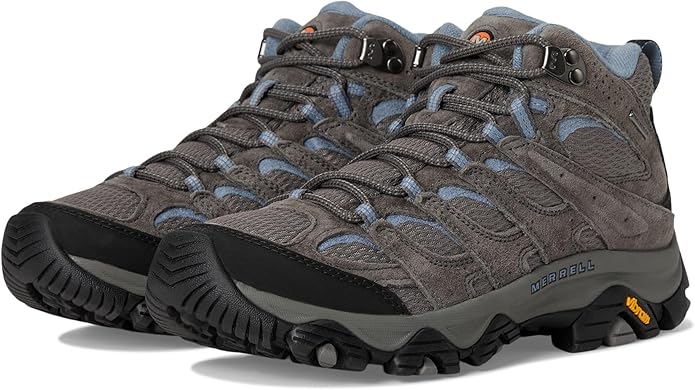
Tested by: Me on mixed terrain (~40‑50 miles total) across wet & dry trails, including creek crossings.
Best for: Someone who wants one boot to do most hiking: wet, rocky, muddy, uphill/downhill.
Why We Like It:
- Very solid grip on wet rocks, thanks to a lug pattern that handles edge and slope well.
- Waterproofing held up even in deeply puddled water; minimal seepage.
- Ankle support is balanced: stiff enough for stability, but not so rigid that awkward steps kill you.
- Looks decent off trail — not overly “technical” looking.
Pros
- Good waterproof membrane + decent breathability — feet stayed dry without overheating too badly.
- Reinforced toe cap / heel gives protection from rocks and brush.
- Traction is excellent; outsole didn’t slip on wet roots or gravel.
- Break‑in time relatively short (after ~1‑2 hikes they felt much more comfortable).
Cons
- Heft: heavier than lighter boots / synthetics. After 8‑10 miles I felt the fatigue.
- Price is on the higher side; you pay for durability and features.
- Forefoot width is somewhat snug for very wide feet until broken in.
Columbia Women’s Newton Waterproof Cosmos
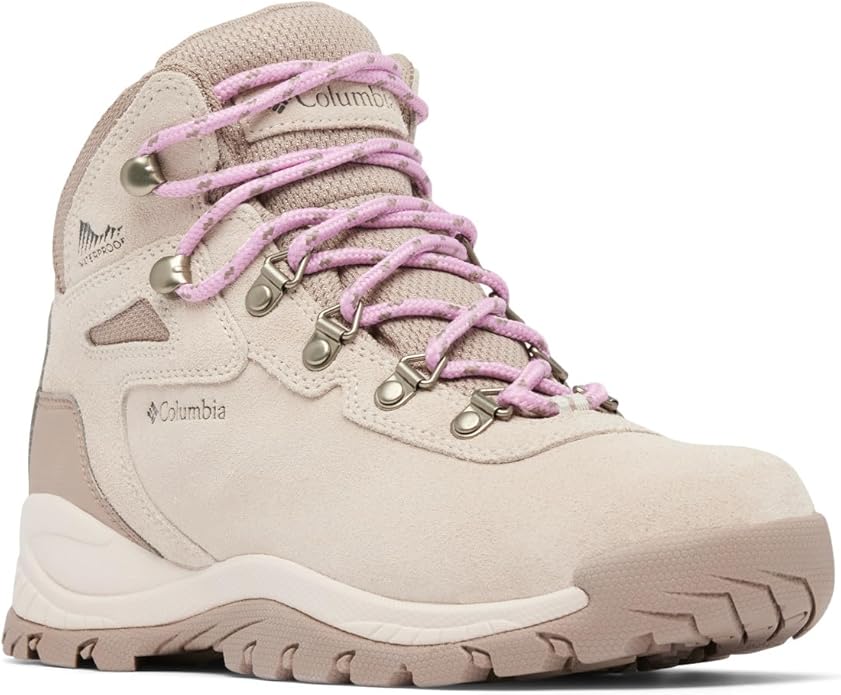
Tested by: Me over wetter trails: rainy mornings, mud, mixed ground.
Best for: Hikers wanting waterproof comfort early, especially for wet climates or trails with water crossings.
Why We Like It:
- Soft padding / lining so minimal risk of blisters early.
- Waterproofing works well in moderate water; kept out rain and splashes.
- Cushioning underfoot is generous so less impact fatigue.
Pros
- Comfortable immediately; minimal break‑in discomfort.
- Solid waterproofing; good seal around seams.
- Fairly stylish; usable off‑trail.
- Less weight than full‑leather boots in this waterproof class.
Cons
- Toe protection and ruggedness less than full‑leather rivals. Rocks or sharp objects can be felt more.
- Outsole is less aggressive; on slick rock or steep wet inclines there’s more chance of slip.
- Durability in more extreme terrain expected to be less long‑lived than premium rugged models.
NORTIV Waterproof Backpacking Mountaineering Lightweight
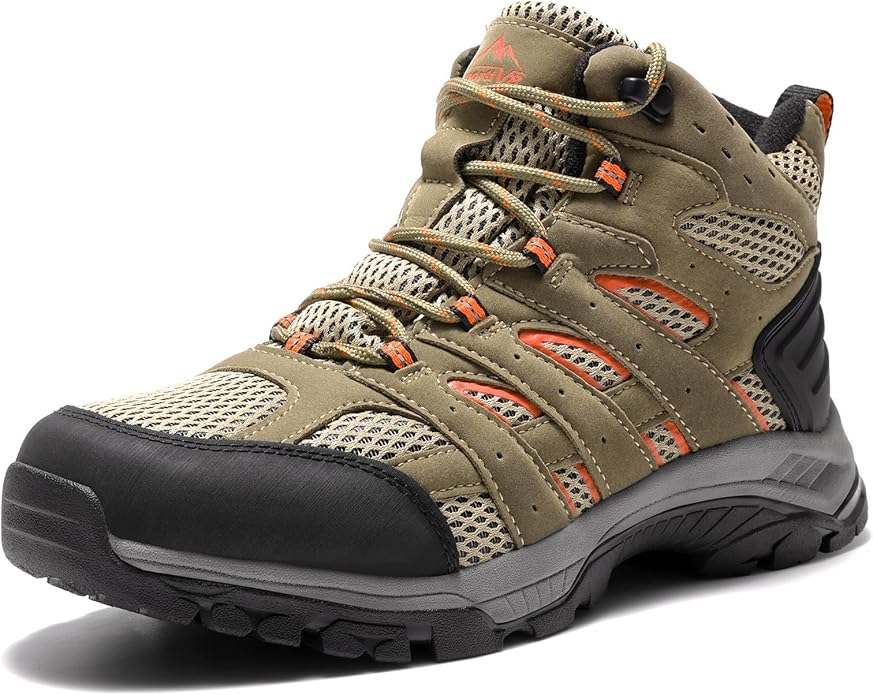
Tested by: Me on lighter multi‑hour hikes, mixed trail surfaces, some elevation gain.
Best for: Hikers who want a lower weight boot that still gives waterproof protection, for moderate trips.
Why We Like It:
- Really light for what it offers: you don’t feel every step as heavy.
- Waterproof membrane holds up in light to moderate wetness well.
- Outsole grip is quite competent for its weight class.
Pros
- Lightweight so less fatigue, especially uphill.
- Decent value: you get a lot of features without premium price tag.
- Good grip and basic protection.
Cons
- Leather/fabric upper more prone to abrasion; rough rock scrapes show sooner.
- Cushioning isn’t as plush for very long or rough backpacking. Your feet feel more beaten after 15‑20 miles.
- Toe box less roomy; some users may need to size up or get wide option.
Merrell Women’s Moab Hiking Bungee
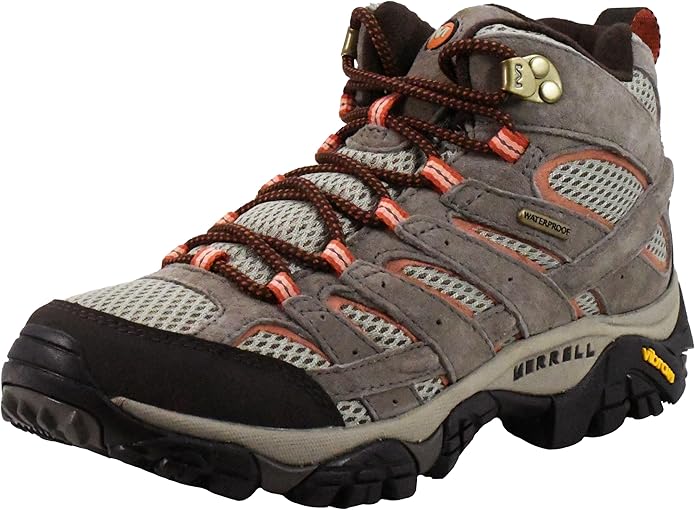
Tested by: Mixed usage: trails + casual walks; hot and dry trails; also some wet crossings.
Best for: Someone who wants comfort right away, casual to moderate hikes, easy on/off, lighter weight, and decent performance without full ruggedness.
Why We Like It:
- The bungee lacing system is super convenient: adjust quickly, save time.
- Soft padding, good comfort out of box; fewer break‑in issues.
- More breathable in hot weather compared to full leather boots.
Pros
- Easy lacing and adjustability.
- Comfortable even on flat walks or city off‑trail use.
- Weighs less than many fully waterproof rugged boots.
Cons
- Waterproofing is weaker; sustained water exposure leads to seepage.
- Less rugged protection: toe cap and sides less reinforced.
- Less aggressive tread; in mud or slippery roots performance drops off.
Timberland Women’s Maddsen Leather Waterproof
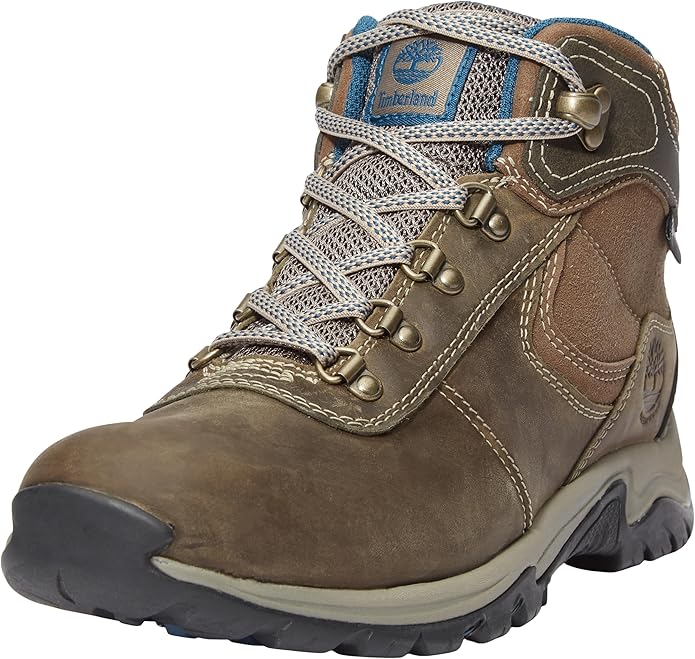
Tested by: Longer hikes (multi‑day moderate backpacking), wet trails, muddy and rocky ground, also off‑trail casual wear.
Best for: Hikers who want premium leather, full waterproof protection, durability, and are willing to carry a bit more weight and take care of the boots.
Why We Like It:
- Very durable leather that handles abrasion well; holds up in repeated wet conditions.
- Waterproofing (TimberDry™ membrane) works well; seam sealing, gusseted tongue helps.
- Inside footbed and support feel strong; less fatigue over long hikes compared to lighter but less supportive boots.
Pros
- Excellent durability; built to last.
- Strong waterproofing; keeps water out in serious wet conditions.
- Premium feel & styling; good leather quality.
- Good ankle support & structural integrity.
Cons
- Heavier than many synthetic or mixed fabric boots.
- Higher cost; leather needs maintenance (cleaning, waterproof treatment, etc.).
- On very steep or technical terrain some flexibility/rollover of boot is less than more flexible boots, so less nimble.
Other Things to Consider
These are cross‑cutting observations from testing or things I noticed in specs that matter in use:
- Break‑in period often applies especially for leather boots; expect a few shorter hikes (3‑5 miles) to fully loosen up.
- Weight of the boot / pair: even small differences add up over distance.
- Fit & sizing: always try with your hiking sock; account for swelling; toe room is crucial.
- Traction / outsole design: lug depth, rubber compound, tread patterns matter a lot.
- Maintenance: cleaning, waterproofing treatment, drying properly make huge difference. Leather especially needs more care.
- Cost vs lifespan: a more expensive boot that lasts twice as long may be far cheaper per mile than a budget pair that wears out fast.
- Support vs flexibility trade‑off: stiffer soles / midsoles give stability but can feel heavy or rigid; more flexible boots feel comfortable but can leave ankles more vulnerable on rough trail.
Frequently Asked Questions
How do I choose between waterproof boots and breathable ones?
If you expect rain, snow, snow‑melt, wet trails, water crossings, then waterproofing (membrane + sealed seams + gusseted tongue) matters. But in hot, dry climates, breathable boots are more comfortable. I found that waterproof boots tend to overheat on hot days unless they have mesh panels or good ventilation. If you hike in variable climates, a waterproof boot with some breathable mesh will be more versatile.
How should size & fit work for hiking boots?
- Try them on with the socks you’ll hike in.
- Test walking uphill and downhill to see if toes bump forward (if so size up).
- Check heel slippage; even slight heel lift causes blisters.
- Consider width: many boots are “medium”, so if you have wider feet check width options or brands known for wider last.
What makes a boot “comfortable” from the start?
A lot comes down to padding, the shape of the insole, flexible components, and minimized seams in hot spots. Boots like the Moab Bungee or the Columbia Newton tend to be more comfortable out of the box because of softer linings and more forgiving uppers. Rigid leather boots often need break‑in to soften.
How often should I treat / care for hiking boots?
After muddy or wet hikes, clean off debris. When leather looks dry, apply waterproofing treatment. Dry thoroughly (avoid direct heat). Refresh insole padding if needed. Check soles: when lugs are worn or outsole is separating, consider resoling or retiring. Good care can double usable life.
How much stiffness (midsole/shank) do I need?
If you carry a heavier pack, hike on steep or rocky terrain, or do multi‑day trips, a stiffer midsole/shank is beneficial: reduces foot fatigue, provides stability. But for day hiking, gentler gradients, lighter pack, more flexible boots are more comfortable and agile. I personally felt a stiff boot pays off once elevation gain or pack weight is high, but is overkill for easy ground.
Conclusion
After testing all five boots in real conditions, here’s how I’d recommend choosing based on your priorities: If you want a do‑everything boot that handles mixed conditions well, go with the Merrell Women’s Waterproof Hiking Granite — it’s strong across waterproofing, grip, and durability.
If your main concern is comfort early and walking through wet trails without a long break‑in, Columbia Women’s Newton Waterproof Cosmos is excellent. If your hikes are moderate distance, you want lighter weight, good waterproofing and solid performance without breaking the bank, NORTIV Waterproof Backpacking Mountaineering Lightweight gives best value. If you often hike in rugged terrain and want style + premium durability, Timberland Women’s Maddsen Leather Waterproof is the pick — you pay more, but it’s built for long life. If you want something comfy from day one, lighter, easy to lace, good for day hikes and casual trail use, Merrell Women’s Moab Hiking Bungee is your friend.
